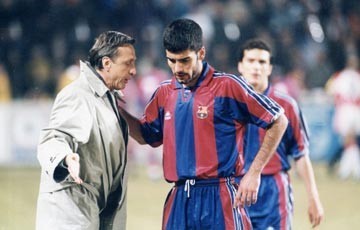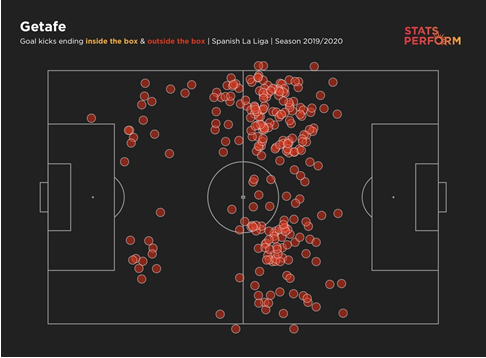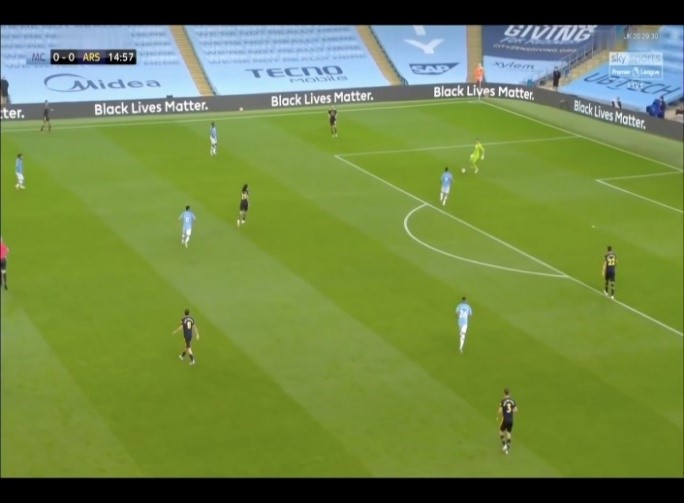I was watching the FA Cup final between Arsenal and Chelsea a few months ago and a special moment in the game caught my eye. It was the moment where Arsenal’s Nicholas Pepe (see image below) was near his own penalty box trying to bring the ball out from the back. It seemed risky when Pepe played a pass to David Luiz but the rewards were worth it when Aubameyang found Pepe a few seconds later with a lot of space ahead of him through a third man pass. Pepe, on receiving the ball, played through the Chelsea defence breaking multiple lines into the path of Ainsley Maitland-Niles. The move didn’t account too much in the end with the ball going out for a goal kick. I was enthralled by that move and was pleasantly surprised to see the improvements Arsenal had made in a few months in the execution of their build up. It was then that I decided to dig deep into build up play and excavate the small details that would help in performing a successful build up from the goalkeeper.

You can see in the above images how Arsenal progress up the pitch through build-up which helps them create a free man.
Arsenal’s build up play has been the talk of the town off late with the Aubameyang goal in the Community Shield match against Liverpool a good example of it. This is something that has been worked on in the training ground by Arteta and his staff in the last few months because Arsenal until mid-February (only 2 months intro Arteta’s reign) had the lowest progress in the Premier League from both short and long goal kicks (Source – Tom Worville). In the last few months, Arsenal’s build up play and subsequent progression up the pitch has been eye catching with positive end results (often progressions into the opponents half and sometimes into the opponents penalty box).
Arteta – I get nervous when we kick the ball long
This piece will cover:
• Origins of the build up
• Definition of a build up
• Why do teams build up?
Origins of the Build Up
It’s difficult to find the exact origin of when teams started building up but it can be assumed that early proponents of the possession game like Arthur Rowe, Stan Cullis and Vic Buckingham might have encouraged their team to play out from the back. There are other interesting and revolutionary coaches/teams too like Herbert Chapman and the famous Hungary team of the 1950s who rewrote the history books with their possession based attacking style of play. The latter didn’t show signs of repetitive build up play from the Goalkeeper but there was a recognisable intention to possess the ball and break lines to progress through the pitch. I found an interesting bit from Marti Perarnau’s book – Pep Evolution, which spoke in detail about Guardiola’s time at Bayern Munich but also included this passage about the build up from the early 1900s.
‘In 1901 Needham wrote these words for an Association Football publication:
“Sometimes, and I’d like to emphasise this point, linking up play between defenders and midfielders is a good decision. If a defender can feed the ball to his midfielder so he can then push the play up the pitch he should do that without hesitating for a second instead of simply launching the ball long and far with a big hefty boot. This approach is much more successful than the way teams habitually play. Too many defenders, whenever they have the chance, just lump the ball as hard as they can and reckon they’re pretty heroic. They’re totally forgetting that nine times out of ten the ball flies over the head of their striker, landing at the feet of the rival back four who then counter-attack because you’ve gifted them possession.” I think Lillo and Guardiola would have got on pretty well with Needham and indeed with Jimmy Hogan, another like-minded English coach of whom Norman Fox wrote, “Hogan maintained that the best and safest way of playing was to bring the ball out carefully from the penalty area and move forward using short passes. Although he had nothing against long passes per se, he said that precision was essential. In fact he insisted on precision. Thumping the ball long only to end up giving it to the opponent was never part of his tactical plan.”

In the 60s, playing out from the back wasn’t as popular as it is now after the efforts of Johann Cruyff, Louis Van Gaal and Pep Guardiola who have been big advocates of positional play, of which build up is a key tool that helps start the attack. Playing out from the back is now seen by most top clubs as a non-negotiable since they see first-hand how building up helps you control the ball and as a result the game too. There have been other advocates of build-up play in Ricardo La Volpe and Juanma Lillo, both of whom have inspired Guardiola. Pep Guardiola wrote in El Pais in 2006, “La Volpe obligates his teams to play out from the back, which means players and the ball advance together at the same time. If only one [player] does it, there is no reward, no value. They have to do it together, like couples do when they go out together.” You can already see the importance Guardiola gives to the collective (players and ball) advancing together in order to gain the reward of the build-up – a goal. He also recognises the risk attached to it
“A lost possession from where they play the ball out from could be terrible. But not only do they know it, everyone knows it. That’s why everyone evades doing the same as the Mexicans. Some start play, others play out.” La Volpe gave birth to the famous ‘la salida lavolpiana’ which translates to ‘the la volpe exit’ in reference to bringing the ball out from the back.
‘Because playing out from the back isn’t the goalkeeper giving it to the centre-back and the centre-back passing it just for the sake of it. The job is to get the ball into midfield with numeric superiority, with a man spare. And if you don’t have a man spare in the middle of the field after playing out, it’s because the opponent left you man-on-man further forward.’ (La Volpe in an interview to ESPN in 2018)’
You can see in the video above how the La Volpe exit works. The two centre-backs spread out to the edge of the box where the two strikers follow them leaving space for the defensive midfielder (6) to step in relatively unopposed and progress the ball up the field. The concept revolves around numerical superiority and creating space for your team mate by dragging your rival in a direction far from the ball recipient. You can find more on this topic here
Another interesting man that Guardiola credits for influencing his style and philosophy is Juanma Lillo, who is now reunited with Pep at Manchester City. In Perarnau’s book, there is an interesting passage where Lillo is explaining his thoughts on the build-up:
‘If players don’t take the time to construct play it will be difficult to get the ball to the right places up the pitch and then dominate the opposition. If you play the ball up field at top speed all the time, hitting first time long balls, the ball will be back on top of you in seconds. Up and down, up and down . . . You have to pass when the moment’s right, to the right player. Get that wrong and you’ll be playing long balls for your opponents to gobble up and then come at you in numbers.’
There is a common trend of risk vs reward in the statements of these famous coaches. What we can already gather is that while it is risky, the reward can be fruitful because reaching a certain area on the pitch with more numbers than the opponent is likelier to generate scoring opportunities. To reach the midfield zone with numerical superiority requires a great relationship and a deep, synchronised level of understanding the game (functionality) between the players. Maybe this is why coaches like Guardiola and Gasperini spend hours on the training ground trying to perfect the execution to improve the functionality and automatism of the players. If I have to sum up what the coaches above say about build up, two key points come to mind – to move together in a collective but at the right moment.
On the left you can see Arsenal starting their build up vs Manchester City. On the right you can see Arsenal entering the opponents half with a numerical superiority 10 seconds later.
Build up – What is it?
To build up would mean to reach the opponents half preferably in an advantageous situation (a superiority so to say). To build up, you can use short passes, long passes or a dribble and these are all valid as long as you reach the opponents half in a superior position. While watching the UEFA Champions League semi-final between PSG and Red Bull Leipzig, there was an interesting moment when PSG scored their second goal from a build-up error by the Leipzig goalkeeper. The commentator said this, ‘there is a difference between playing out from the back and playing from the back. The former means you play out and reach the forwards. The latter means you play from the back and risk losing possession’. This is an interesting categorisation between two terms, the first implies that you are building up from the back with an idea to reach the forwards while the second implies you are playing for the sake of playing without an idea or awareness of your execution.
For the purpose of our research in this article we have only accounted for build-up actions when the Goalkeeper is involved (mostly by passing) in the build-up. This doesn’t necessarily mean that a build-up is not possible without the goalkeeper’s involvement since there are plenty actions when the ball has been recovered by or passed to an outfield player in the defensive third who is able to build up and reach the opponents half without using the Goalkeeper. This is typical when the opponents prefer to setup in a mid or low block. Having said that, there is a lot of advantage to the goalkeeper’s involvement in build-up play. The biggest being using the extra attacker and stretching the field of play and, as a result, increasing the distance between the first and last defender. With the Goalkeeper’s involvement, you can start setting your structure which will help you progress up the pitch.
There is an interesting tweet I stumbled upon which speaks about the difference between a long ball and a long pass towards the depth of the pitch. There is a big misconception in football that a long pass is against the fundamental idea of build-up. We disagree. If you look at the definition above, a long pass is a great means of reaching the opponents half in an advantageous situation. Manchester City Goalkeeper Ederson is a master of using the long pass to exploit spaces in the opponent’s defensive structure. But that comes through a combination of training, the players’ understanding of your idea and their ability to execute that idea on the pitch. A good example of this is Guardiola overhauling his back line in the last few years with recruits/additions like Mendy, Zinchenko, Danilo, Walker, Cancelo, Laporte, Ake and Garcia to help achieve his style.
Having said this, if a team uses the long ball for major periods of the game without a clear idea of achieving superiority and relying on the second ball / a flick on, that would not be considered a ‘build up’ since the chances of reaching the opponents half in an advantageous situation is something you can’t control.

Domenec Torrent said in a recent interview with Graham Hunter, ‘It’s easy to play long ball. For example you play long ball, you recover the second ball, its okay. But when the ball is in the air, you don’t know what will happen with the ball. Sometimes people say it’s dangerous to make a build-up. I don’t agree. Because if you make a build-up you know exactly when you want to do. You are in control.’ Hunter compared build up to counting cards in a casino – ‘if you can count the cards, you might still lose but you give yourself a big opportunity. It’s the same thing you give yourself a higher chance by having more percentage, more control of the ball’.
Since superiorities are important to the idea of build-up play, we will briefly talk about the 5 superiorities that exist with teams that practice positional play.
1) Numerical superiority- This refers to having more numbers than the opposition in a certain space on the pitch.
2) Positional Superiority – When player/s are positioned in a superior (vacant) space on the pitch
3) Qualitative Superiority– An individual or group having superior quality (technical/physical/mental) than the opponent/s. This can be as simple as a player having more technical quality than the opponent (Thiago Alacantra vs his direct opponent / Messi vs a group of opponents) or a superior physical quality (Bayern Munich players in the quarter final vs Barcelona).
4) Dynamic Superiority– Having a spatial and awareness superiority over the opponent where you can exploit space better than the opponent. A simple way to explain this superiority would be to label it ‘dynamic space occupation’ or ‘momentum superiority’ since it is better to arrive onto the ball than receive it static from your position. This superiority makes it easier to attack and harder to defend.
5) Socio Affective Superiority– connections and relationships between players and teams. The stronger this superiority, the easier to play with each other. This is an important superiority because one addition to the game can often change the flow and dynamics between the groups. A good example is Kingsley Coman who started the Champions League final against PSG because Hansi Flick felt Coman would have a point to prove against his boyhood club.
Why do teams build up?
There is no short way to answer this question but there lies a lot of sense behind what Guardiola, Lillo, La Volpe and Torrent say about their affinity towards the build-up. Most coaches now prefer the build up to dominate the game using the ball. Juanma Lillo had this to say about his belief -‘If you develop your play slowly you’ll be under pressure from the start, for sure. But if your football’s very fast and direct you’re going to have the ball thrown back at you almost immediately. In football, to get up high, you need passing movements in the main part of the pitch.’

It’s fascinating how football has evolved over the years. In the past, we saw a lot of teams trying to dominate the opponents without the ball but we are now seeing a change where teams recognise the value of the ball. More teams than ever now want to be the protagonists of the game, trying to dominate the opponent using the ball. In the Serie A, there has been a 20% rise in short goal kicks and there has been an increase in other leagues too since the new goal kick rule has come into effect. Brighton and Hove Albion is one team who under Chris Houghton were taking 7% of their goal kicks short and this year under Graham Potter, the number of short goal kicks has gone up to 77%. (Source – Tom Worville) The recent Europa League winners (Sevilla) are a good example of suffocating the opponent using the ball to reach the opponents half and dominate even further. The Italian teams (Roma and Inter Milan) learnt that the hard way. But if we had to look deeper into why teams prefer to build up, we will find many layers to that answer.
1) Control – The biggest reason is so teams can control the game with the ball. In an article in the Telegraph, JJ Bull wrote ‘at the elite level, managers should seek to control as many aspects of a match as they possibly can and although throwing a dice will occasionally make it come up six, there are too many uncertainties and possession cannot be guaranteed. By building up from the back a team can be coached to construct attacking play under conditions the manager has chosen.’ Another excerpt from Guardiola’s time at Bayern should give us a better explanation behind his philosophy of playing out from the back, ‘I said to them, “Okay, you like long balls? No problem. But you should understand one thing – the faster the ball goes, the faster it comes back.” It’s just one of those bloody things you have to accept in football. In eight out of ten situations when you kick the ball long, the opposition central defender is going to get to it and win it back. You’re running after it and it’s already on its way back. ‘They’d say: “Who cares! Get it up the pitch right away, hit the ball long.” It was a fucking pain in the neck to get it over to them and I had to explain it over and over again, as no doubt I’ll have to in England as well.’ By controlling the game through possession of the ball, you can also manage the tempo of the game along with the rivals’ intentions. This is why Guardiola prefers the 15 pass rule before attacking the opponents goal and without the build-up this is impossible.
2) Connection – The next reason for the build-up is so you are connected as Guardiola said earlier ‘like couples’. If you bring the ball out cleanly by staying connected through the pitch with the right distances, you can keep possession effectively and make your transition to defence easier. Pep explaining how he won the ball back so quickly during his time at Barcelona, ‘this happened because we’d move forward together as a team. There wasn’t much space in between the players or the lines and when they lost the ball it was usually easy to get it back’.
3) Progress – The connectedness in the build-up also allows you to progress up the pitch together moving from one zone of the pitch (your penalty box) to the opponents half without breaking your structure. Tom Worville, who measured some data in the last two seasons found on average teams that take a short goal kick progress up the pitch 49 meters as opposed to teams that take a long goal kick and progress up the pitch 39 meters. This comes as no surprise really because if you read what some positional play experts have said above, you will realise that the best way to progress with control and superiority further up the pitch is by playing out from the back.
4) Superiority – Another reason why the build-up is of value is to create superiority behind the line of pressure. If you build up, it is likely that at some point the opponents are going to press you. By attracting rivals, you can create superiority behind them allowing you to progress up the pitch with a numerical superiority. In a build-up, the team always moves up the pitch as a unit. As a result you stand to have greater numbers in front of the opponent’s goal compared to the long ball where you give the opponents the possibility to recover the lost numbers.
5) Unpredictability – The build-up also allows your team to mix things up and as a result, makes your team unpredictable and difficult to press. Michael Cox said in the Athletic’s Zonal Marking podcast that the major impact of the new goal kick rule has seen a change in the way teams press. ‘It’s actually quite difficult now to press on goal kicks and the greatest example of this is Manchester City. On one hand Guardiola’s teams want to play out from the back but on the other hand because you can’t be offside from a goal kick, City have exploited that a lot with Ederson just hoofing the ball over the entire side, often to Sterling or Aguero or Sane running through. So, because teams are so focused on being compact, it’s very difficult to be compact if you can’t play an offside trap like you usually would and you’ve now got to cover 18 more yards up the pitch. So we’ve seen teams just spread across the pitch in a way that we really have wouldn’t seen before’ says Cox. Having a goalkeeper with the kicking range and accuracy of Ederson helps to give you the option of going direct towards the strikers or exploiting spaces between the lines for the strikers, midfielders and fullbacks to receive in. If you are defending against Manchester City’s goal kicks, you can’t afford to give them an inch of space because they will exploit it. If you press them high, they will use the space behind you and if you drop in a low block, they will play the short pass to the Centre-back and build play from there. Stewart Robson explains it perfectly in his piece for ESPN, ‘starting moves from deep also allows teams to make the pitch “bigger.” Coaches have long used that term in relation to width, but with players dropping so far to receive the ball from their goalkeeper, as well as strikers threatening space behind opposing defenders, making the pitch “big” is equally applicable to length. This makes it more difficult for defending sides to remain compact.’ The build-up is the start of your attack and the more weapons you can have in your arsenal, the easier it is to achieve your objectives.
6) Enjoyment – Lastly, the players enjoy when they are in possession of the ball. Andrea Pirlo wrote this in his dissertation, ‘There are big benefits to bold, attacking football. There’s more of a feel-good factor. Players and staff buy-in more. You need all that to forge the empathy behind all successful teams.’ Guardiola, who is a pioneer of this attacking football philosophy and when questioned on it, he said in an interview to SFR sport ‘football players became football players because they enjoy to play with the ball and I try to let them enjoy remembering when they were young players.’
You can also read this article here.
Stay tuned for PART 2 that’ll include: Principles & Patterns
About the Authors:
Saksham Kakkar – coach at Reliance Foundation Young Champs, tried to reach his dream of playing the sport professionally & took up coaching & is now trying to change the landscape of the sport in the country.

Dipankur Sharma – a player-centric coach who believes in the importance of building connections to ensure players reach their potential both on and off the pitch.







Sunny Kumar
21 Dec 2020Thank you Coaches for the deep knowledge about the build up play👍🏻
Harshit Raval
23 Dec 2020One of the best articles I’ve read till date. Detailed and up to the point. Eagerly waiting for part 2.
SUSHANT Naidu
23 Dec 2020Very Informative
Pingback: Dissecting the Ins & Outs of build up play — Part 2 – AIFC Blog